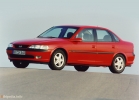Protection of the driver and passenger

Frontal blow, driver |

Loba blow, passenger |

Side blow, driver |
 | - | Excellent |
 | - | Good |
 | - | Satisfactorily |
 | - | Badly |
 | - | Very bad |
|
Children's holding devices
| Child up to 18 months |
No information |
| A child over 3 years old |
No information |
Safety of pedestrians
 |
 | - | Excellent |
 | - | Good |
 | - | Satisfactorily |
|
Comments:
During the frontal impact, a crump of foot depression occurred, and during the side, the driver was at risk of getting a life -threatening breast injury: the car did not meet the safety requirements for lateral blows introduced in the EU in October 1998. The displacement of the steering column inside the cabin also concerned experts. However, with a lateral strike, the driver’s head and the pelvic area of \u200b\u200bthe driver were good.
Frontal blow:
The left front stand shifted back only 57 mm, and the passenger salon retained structural integrity. The driver's door could not open normally due to damage to the handle. The passenger door was almost not injured. The steering wheel shifted back 58 mm and upward 82 mm. The deformation of the recess for the legs was insignificant, the brake pedal shifted back 134 mm. The evaluation for the protection of the head was reduced due to the shift of the steering wheel. This could lead to an even greater danger when placing a higher or low driver behind the wheel. The neck is well protected. Passive safety systems saved the driver’s chest from contact with the steering wheel, although the load transferred by the seat belt represented some risk of damage. Protection of knees, legs and pelvis is recognized as good, but a low rating for protecting the lower leg of the left leg is set. The crushing of the recess for the legs led to a decrease in the assessment for protecting the feet and ankles. The general protection of the front passenger is good, although the load from the belt belt was a danger to the chest.
Safety of passenger children:
Explanations on the stickers are not clear, but the attached instructions were better.
Side blow:
The driver’s head and pelvis are good, but the sensors in the mannequin body showed that due to the side blow of the car, the chest could get serious injuries, including life-threatening. The abdominal department was also subjected to traumatic loads.
Pedestrian safety:
Protection of the head of the child. Only one of the six control points was consistent with regulatory requirements - above the rib of the hood stiffness. Two more points provided protection better than average, and one was close to the implementation of the standard. Three points turned out to be worse than the average: above the flood neck of the coolant tank, above the air filter and above the counter -absorber. Protection of the upper part of the legs. None of the three control points comply with the requirements. All places on the front edge of the hood protected better than average. Protection of the head of an adult. Not a single point corresponded to the standards. Four turned out to be better than average: above the janitor, near the nozzle nozzle, above the edge of the motor compartment partition and one point on the roof of the hood. Feet protection. Not a single point comply with safety requirements.
General information about the car
| The location of the steering wheel |
On right |
| Tested model |
Opel Vectra 1.8i |
| Type of body |
5-door hatchback |
| Year of data publication |
1997 |
| Curb weight |
1300 |
Safety system equipment:
| Front seat belts |
There is |
| Front seat belts load limiters |
Not |
| Front Pillow of Safety of the driver |
There is |
| Passenger front pillow |
Not |
| Side airbags |
Not |
| Side pillows of head safety pillows |
Not |
| Knee -off pillow and legs of the driver |
Not |
















